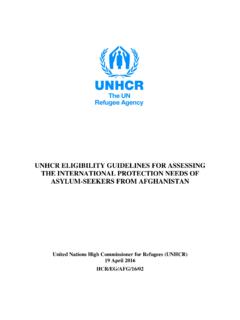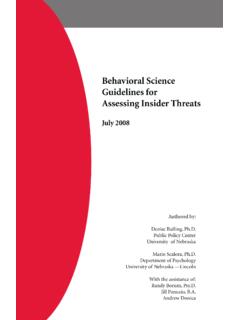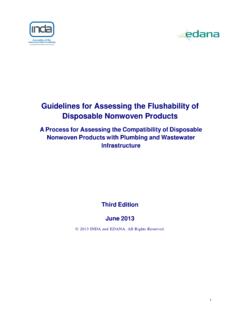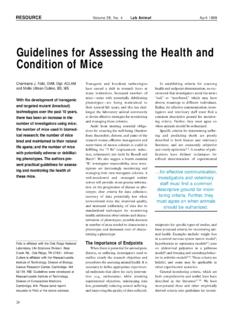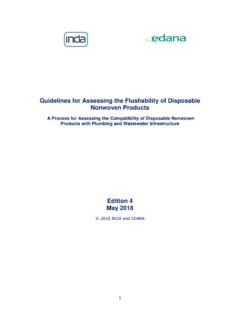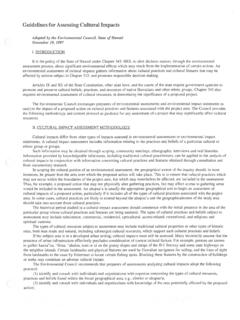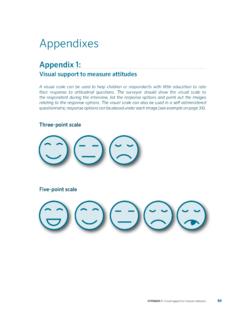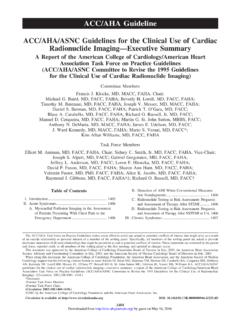Transcription of Guidelines on assessing biodiverse foods in dietary intake ...
1 Guidelines on assessing biodiverse foods in dietary intake surveysGuidelines on assessing biodiverse foods in dietary intake surveysFood and Agriculture Organization of the United NationsRome, 2017 Prepared by:Gina KennedyWarren LeeC line TermoteRuth Charrondi reJi Yen Alexandra TungThe designations employed and the presentation of material in this information product do not imply the expression of any opinion whatsoever on the part of the food and Agriculture Organization of the United Nations (FAO), or of the Bioversity International concerning the legal or development status of any country, territory, city or area or of its authorities, or concerning the delimitation of its frontiers or boundaries.
2 The mention of specific companies or products of manufacturers, whether or not these have been patented, does not imply that these have been endorsed or recommended by FAO, or the Bioversity International in preference to others of a similar nature that are not mentioned. The views expressed in this information product are those of the author(s) and do not necessarily reflect the views or policies of FAO, or the Bioversity 978-92-5-109598-0 FAO and Bioversity International, 2017 FAO encourages the use, reproduction and dissemination of material in this information product. Except where otherwise indicated, material may be copied, downloaded and printed for private study, research and teaching purposes, or for use in non-commercial products or services, provided that appropriate acknowledgement of FAO as the source and copyright holder is given and that FAO s endorsement of users views, products or services is not implied in any requests for translation and adaptation rights, and for resale and other commercial use rights should be made via or addressed to information products are available on the FAO website ( ) and can be purchased through comments, questions and additional information, please contact.
3 The Director, Nutrition and food Systems Division, food and Agriculture Organization of the United Nations (FAO), Viale delle Terme di Caracalla, 00153 Rome, Italy. E-mail: Fax: + 39 0657054593 Recommended citation: FAO and Bioversity International. 2017. Guidelines on assessing biodiverse foods in dietary surveys. FAO, photo: FAO/Ruth Charrondi reiiiContentsForeword ..viiAbout this document ..ixContributors ..ixAcknowledgements ..ixList of abbreviations and acronyms ..x1. Introduction ..12. Previous Work .. food Consumption data on Biodiversity ..73. Purpose of the Guidelines .. What gaps do these Guidelines fill? .. What do the Guidelines not encompass? ..104. Preparation for Tool adaptation.
4 Preliminary steps to collect information needed to capture biodiverse foods in dietary assessment tools .. Step 1: Create a multi-disciplinary team .. Step 2: Perform a literature review .. Step 3: Define the foods and/or food groups for investigation at subspecies level .. Step 4: Conduct an assessment of food biodiversity within the food system at the appropriate level of taxonomic detail.. Verification, harmonization and finalization of subspecies food list for use in dietary assessment tool ..265. Selecting and adapting a dietary intake instrument .. Selecting the dietary intake instrument(s) .. Adapting the dietary intake instrument .. 24-hour recall .. The food record method.
5 The food Frequency Questionnaire .. The dietary Diversity Questionnaire .. dietary History .. Using technology to collect information with adapted dietary surveys ..396. Post Assessment .. Analysing and reporting food consumption data including biodiverse foods ..417. Areas to be strengthened and next steps ..438. Conclusion ..459. References ..47 ANNEXES ..52 ANNEX 1: Definition of terms and taxonomy related to food 2: Criteria for the inclusion or exclusion of foods for Nutrition Indicators for Biodiversity (indicator 1 and 2) ..57 ANNEX 3: Further reading and additional sources of information ..58 ANNEX 4: Example of data collection tool for taxonomic identification of local foods .
6 61 ANNEX 5: dietary Assessment Instruments potential for adaptation to include biodiverse foods ..63 ANNEX 6: Enumerator instructions and example of an adapted 24-hour recall form ..65 ANNEX 7: Example of adapting a food record ..67 ANNEX 8: Example of an adapted food Frequency Questionnaire ..69 ANNEX 9: Additional example of food Frequency Questionnaires (FFQ) (Self-administered)..74 ANNEX 10: Examples of adapting the dietary Diversity Questionnaire ..75 ANNEX 11: List of Participants in the FAO Technical Meeting in Granada, 21-22 September 2013 ..80vlist oF tABles Table 1 - Potential team members needed to document biodiverse foods within the considered food system ..14 Table 2 - Potential inclusion criteria for biodiverse foods .
7 20 Table 3 - Information to be collected and tools which can be used to assess food biodiversity ..24 Table 4 - Examples of additional characteristics of food consumed that can be included in the questionnaire ..33 Table 5 - Example of subspecies food list and food codes ..35 Table 6 - Cultivars of eggplant consumed by households in Saturia region of Bangladesh ..41list oF FiGures Figure 1 - Relationship between food biodiversity investigation and survey scope ..18 Figure 2 - Decision Tree to guide the collection of dietary intake information related to biodiverse foods ..31list oF Boxes Box 1 - Definitions of Nutrition indicators for Biodiversity and biodiverse foods for food Composition and food Consumption.
8 6 Box 2 - Snapshot and objectives of steps involved ..12 Box 3 - Examples of additional possibilities for Box 4 - Special Considerations when measuring food foods systems are facing mounting challenges to provide growing populations with safe, diverse and nutritionally adequate foods because of resource constraints, environmental degradation as well as the continual narrowing of the food base and the loss of biodiversity. Biodiversity is intricately intertwined with food security and nutrition, for it is critical to the availability of nutrients needed to support health and well-being, as well as to the sustainability of the natural resource base upon which food systems is at the heart of the sustainable development agenda.
9 As a follow up to the Second International Conference on Nutrition (ICN2)1, in April 2016, the UN General Assembly proclaimed a Decade of Action on Nutrition for the period 2016-2025, and endorsed the Rome Declaration on Nutrition and the accompanying Framework for Action. Recommendation 10 of the Framework for Action called for the promotion of the diversification of crops including underutilized traditional applying sustainable food production and natural resource management practices. In order to mainstream biodiversity and to improve nutrition at national and local levels, a thorough understanding of the contribution of food biodiversity to healthy diets and sustainable food systems is needed.
10 The Commission on Genetic Resources for food and Agriculture (CGRFA) s Voluntary Guidelines for Mainstreaming Biodiversity into Policies, Programmes and National and Regional Plans of Action on Nutrition recognizes that the limited availability of data on use and consumption of biodiverse foods acts as a major bottleneck in determining the importance of biodiverse foods to food security and nutrition2. dietary assessment surveys provide information on the nutrient adequacy of diets, but few are designed to capture the consumption of foods with taxonomical details below the level of species . Thus, their usefulness for understanding food biodiversity in diets and the nutritional contribution of biodiverse foods is limited.










